New Sky Series ‘Obki’ Helps Children Understand Climate Change | Interview with Obki Creators

Ahead of COP26 – the U.N. Climate Change Conference taking place next week in Glasgow – a new series has been airing on Sky Kids; one that aims to help children understand climate change. Produced by London based Ritzy Animation, the new 15-episode series Obki follows an alien on a mission to save planet Earth, aided by his futuristic sidekick, the Orb.
Aimed at children aged 5-9 years, the two-minute episodes will explore environmental topics in an entertaining way, while showing how our delicate ecosystem affects all those who call planet Earth their home. This new series is a collaboration with Sky Zero – Sky’s campaign to be net zero carbon by 2030 – by using its content and channels to raise awareness of the climate crisis and inspire viewers with actions they can take to protect the planet.
We spoke to series director, Simone Giampaolo (SG), and Ritzy producer Charlie Batho (CB) about the making of the show…
To start with, could you give our readers a little background on Ritzy Animation and what you do?
CB: Ritzy Animation was born 4 years ago over a drink between myself and Dan at the Ritzy Cinema in Brixton. Having worked in the animation industry for a combined 17 years we decided to set up a studio with a strong emphasis on character and personality. Starting in a spare room with just two computers we began by creating short promo’s, logo loops, and explainer films to help build the portfolio. After successfully delivering a wide range of content and attracting a small client base, we relocated to London and began assembling a team.
From there we have grown steadily and gradually increased our output to cover commercials, music videos, online spots, short films and most recently Obki – our first kids TV series! Our goal at Ritzy has always been to create memorable characters which stand the test of time. Whether that be in 2D or 3D, or often some kind of strange hybrid, we believe that it’s personality, charisma and style that bring an animation to life, not the flashy visuals.
The message of the show is very current – to help children understand climate change. Was Obki a show that you have been developing for a while? Could you tell us how it came to be?
CB: Obki was one of the first 3D characters Ritzy ever developed. Upon starting the company in 2017 we were approached by Dan’s old tutor who knew someone in need of an animation test. This turned out to be Amanda Evans, who we met and soon became good friends with. She had an idea for a show which focused around a small orange alien who used his futuristic orb device to time travel between different historical locations. It was a really fun idea and we helped her develop the character from a loose sketch into a 3D character, creating a number of animation tests along the way.
It took a couple of years but Amanda eventually gained interest from a major broadcaster, however, they advised her to tweak the narrative to focus on environmental issues, rather than historical education. What followed was another year of development whereby we designed his underwater home, came up with story ideas, and ultimately reimagined his world. It was really important to ensure the series could tackle big issues in a light, comedic, entertaining way.
Essentially, Obki’s mission to save the planet became the heart and soul of the show. Thankfully Sky were on board with the changes, believed in the concept, and we were commissioned to make 15×2!
The series covers a wide range of environmental issues. How did you select which topics to tackle; was this your decision or were you given the topics by Sky?
SG: The broad environmental topics were selected by Sky and Obki Productions and then shared with talented script-writers Evgenia Golubeva and Myles McLeod, who developed them into short Obki stories. The chosen topics had to feel all enough different from each other and easily understandable by young children. Over the writing period, Dan, Charlie and I had the chance to get involved early in the process to review the short stories and give our personal inputs, in order to make them as engaging as possible.
When working with 2-minute episodes, every second truly counts, and being able to tell a clear compelling story in the little available time becomes paramount. As the director of the series, my biggest pre-production challenge has been to take the brilliant scripts from Evgenia and Myles and squeeze them into 120 seconds without affecting the narrative. As it often happens, eventually we had to make small compromises here and there to let it all fit (for example, simplifying some scenes and losing a few lengthy dialogue sentences) but overall we managed to keep the essence of each episode intact!
With the show being produced in the middle of a pandemic and multiple lockdowns, how did you manage the production and pipeline? Was this a huge challenge for you and is remote working here to stay for Ritzy?
CB: The timing of our green light couldn’t really have been any worse from a production point of view. Just as Coronavirus swept the globe and the UK was shut down, we were told to start! Like everyone, we had to make big changes to the way we operated and ran our studio. Taking on our biggest project, it was imperative we got our remote pipeline right.
Rather than buying workstations and having our artists work in-house, instead, we rented virtual workstations from a company called Escape Technology. This meant our staff could spin up a high-spec machine from home in a matter of minutes, and connect to our project server easily.
This approach allowed us to expand or shrink depending on the workforce and not be left with vacant or unnecessary equipment/tools/software. We had a fantastic team of nearly 30 artists that logged on every day to talk Obki and discuss the plan of action over Zoom calls and Slack Chats. Working tirelessly for 8 months with only a handful of trips to the studio, we couldn’t be prouder of the artists for remaining motivated, driven and productive throughout.
We found that since the UK has opened up and we can use the studio more, our artists mostly prefer a hybrid working situation, so we think this is here to stay at Ritzy. We are big believers in having a thriving, creative atmosphere at our studio, and are delighted when colleagues become close friends. Of course, every project has different needs, so we are going to be flexible with the setup moving forward. Furthermore, we feel that coming into the studio is especially beneficial for junior artists who pick up so much from hearing conversations or just being in an environment where they can ask questions quickly.
Can I ask what the turnaround time was for the 15 x two-minute episodes?
SG: We started the actual production of the first episodes of Obki in November 2020, while the writers were still working on the series’ ending. The schedule was quite tight and the overall production lasted around 8 months (from first storyboard to final edit) until June 2021, which gave the team an average of 3 weeks to create each episode! With a tight schedule comes great responsibility…
Obki looks like a very fun character to animate, with a lot of expression and ‘bounce’! Could you take us through his development process; from initial concept, to the final design?
SG: From day one, I immediately ‘felt’ Obki and knew what his personality was going to be like. Obki is all about fun: he’s squishy, loud and clumsy, but behind his flamboyant shenanigans and quirky appearance, he hides a good heart and the naivety/curiosity of a child. Think of Obki as ‘Minions meets E.T.’, but with an ecological twist. Maybe the reason I felt immediately comfortable with him as a character is that I see myself in Obki: nature and the environment have always been themes very close to my heart and, since I started making animation, I’ve always tried to present these topics into my shorts.
The very energetic, pose to pose performance of Obki (often animated using exaggerated poses and smear frames) was well balanced by a more ‘composed’ acting from the Orb. Of course, the actors’ voices helped the animation team massively in this: the incredible Steven Kynman injected a lot of humour and silliness into Obki’s acting, while the very talented Zawe Ashton gave a more cheerful and responsible ‘bigger-sister’ touch to the Orb. I loved working with both of them to explore the characters’ unique traits and nuances.
You utilize some very creative solutions to reduce the animation, while still communicating the story – for example, Orb not having a face/mouth, your use of the TV screen graphics to illustrate complex issues, and the use of matte painted environments. Were these considerations due to budget or time restraints? Could you tell us about these choices?
SG: Of course, these were smart choices we made right at the beginning while keeping time and budget in mind. As you’ll see, in Obki there are several additional animal characters appearing throughout the episodes (such as birds, bees, frogs, fishes, turtles, etc), therefore we couldn’t afford to have the Orb as a second complex character with facial controls and limbs (we wouldn’t have been able to successfully animate so many organic characters simultaneously). We needed to keep her simple and effective for time constraints, but also to easily explain the episodes’ topics to the kids (that’s where the Orb’s holographic screens came in handy): using her as a projector for simple, stylized motion graphics allowed us to explain intricate scientific concepts to the audience in a short amount of time, making the topics accessible to young children too.

We tried to make good use of matte paintings as much as possible to cut environment costs, but sometimes there’s no shortcut: certain elements in the mid-ground (close to Obki or interacting with him, such as walkways, grounds, trees…) had to be modeled and rigged so that they could have the same 3D tactile look as the protagonist. It was necessary to make Obki feel well ‘integrated’.
Can we expect to see any more from Obki? Perhaps a second series or branching out on other platforms
CB: We believe our loveable orange blob has the potential to reach the curriculum in schools, become a leading mascot for environmental change, and remain an iconic kids TV favourite for years to come. There has been a great response to the first series and we’ve been delighted with the feedback so far. The show will be featured at the COP26 conference which should garner a lot of attention and hammer home the environmental causes.

We’d love the opportunity to take him on more adventures and tackle other climate topics but only time will tell … fingers crossed Sky commission a series 2!
All episodes of Obki are available now on Sky Kids on demand for customers across the UK and Ireland. You can also catch the series on Now TV.




